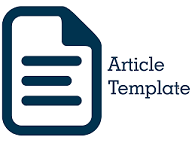Bibliometrical Analysis: Research Trend in Course and Training for Arabic Language
Abstract
Full Text:
PDFReferences
Abu-Mogly, S. (1999). Modern Methods in Arabic Language training. In Dar Magdalawi. Amman. Jordan.
Agbo, F. J., Sanusi, I. T., Oyelere, S. S., & Suhonen, J. (2021). Application of virtual reality in computer science education: A systemic review based on bibliometric and content analysis methods. Education Sciences, 11(3). https://doi.org/10.3390/educsci11030142
Antoun, W., Baly, F., & Hajj, H. (2020). AraELECTRA: Pre-training text discriminators for Arabic language understanding. ArXiv Preprint ArXiv:2012.15516. https://arxiv.org/abs/2012.15516
Bell, J. (2013). Evaluating Army RAPPORT Iraqi Arabic language training in pre-deployment and post-deployment soldiers. academia.edu. https://www.academia.edu/download/67323305/Evaluating_Army_RAPPORT_Iraqi_Arabic_lan.pdf
Bensalem, I., Rosso, P., & Zitouni, H. (2024). Toxic language detection: A systematic review of Arabic datasets. Expert Systems, 41(8). https://doi.org/10.1111/exsy.13551
Bin-Hady, W. R. A., Al-Ahdal, A. A. M. H., & Abdullah, S. K. (2024). The effect of pretranslation techniques in developing EFL students’ translation ability. Journal of Applied Research in Higher Education, 16(4), 1176–1187. https://doi.org/10.1108/JARHE-04-2023-0167
Campo-Redondo, M. S., & Alshamsi, A. R. (2024). Unveiling The Mother Tongue Factor in Dream Work: A Qualitative Ethnographic Exploration of Clinical Psychologists’ Engagement with the Ullman’s Experiential Dreamwork Group Approach. British Journal of Psychotherapy , 40(3), 373–392. https://doi.org/10.1111/bjp.12906
Faheem, M. A., Wassif, K. T., Bayomi, H., & Abdou, S. M. (2024). Improving neural machine translation for low resource languages through non-parallel corpora: a case study of Egyptian dialect to modern standard Arabic translation. Scientific Reports, 14(1). https://doi.org/10.1038/s41598-023-51090-4
Hassan, S., Masri, H., Sawalha, I., & Mortensen, B. (2024). Perceived barriers and opportunities of providing quality family planning services among Palestinian midwives, physicians and nurses in the West Bank: a qualitative study. BMC Health Services Research, 24(1). https://doi.org/10.1186/s12913-024-11216-4
Jebbar, M., Maizate, A., & Ait Abdelouahid, R. (2022). Moroccan’s Arabic Speech Training And Deploying Machine Learning Models with Teachable Machine. In S. E. (Ed.), Procedia Computer Science (Vol. 203, pp. 801–806). Elsevier B.V. https://doi.org/10.1016/j.procs.2022.07.120
Kaab, O. M. (2020). Modern Arabic language training techniques in two secondary schools. sid.ir. https://www.sid.ir/paper/951705/en
Kundakcı, Y. E., & Atay, E. (2023). Bibliometric and visualized analysis of global research on technology in anatomy education from 1987 to 2021. European Journal of Anatomy, 27(4), 517–528. https://doi.org/10.52083/HNNY3374
Mahdi, A. F. (2020). The extent of employing comprehensive quality standards in the preparation and training courses for Arabic language teachers and their teachers in the teaching …. AL-ADAB JOURNAL. https://www.iasj.net/iasj/article/182940
Mahmoudi, O., El Allali, N., & Bouami, M. F. (2024). AMSVT: audio Mel-spectrogram vision transformer for spoken Arabic digit recognition. Indonesian Journal of Electrical Engineering and Computer Science, 35(2), 1013–1021. https://doi.org/10.11591/ijeecs.v35.i2.pp1013-1021
Mohamed, E. A., Ismail, W. N., Ibrahim, O. A. S., & Younis, E. M. G. (2024). A two-stage framework for Arabic social media text misinformation detection combining data augmentation and AraBERT. Social Network Analysis and Mining, 14(1). https://doi.org/10.1007/s13278-024-01201-4
Radi, A. J. (2021). Evaluation of training courses for Arabic language teachers and teachers from their point of view. Contemporary Islamic Studies Magazine. https://www.iasj.net/iasj/article/210754
Rammuny, R. M. (1989). ARABIC LANGUAGE TEACHER TRAINING PROGRAM: Department of Near Eastern Studies The University of Michigan. Al-’Arabiyya. https://www.jstor.org/stable/43208698
Sami, R. (2024). Impact of bilingualism on language development in 46 Egyptian children. Egyptian Journal of Otolaryngology, 40(1). https://doi.org/10.1186/s43163-024-00572-x
Sari, A., & Suyono, J. (2024). Penyembunyian Pengetahuan: Tren Penelitian Analisis Bibliometri Tahun 2018-2023. National Conference on Applied Business, Education, & Technology (NCABET), 3(1), 210–221. https://doi.org/10.46306/ncabet.v3i1.118
Surahmat, S., Mawardi, I., & ... (2023). 20 Days Intensive Arabic Language Training To Improve Maharah Al-Kalam As The First Step In Forming Bi’ah’Arabiyah At Al-Furqon Salafiyah Islamic Boarding …. Prosiding University …. https://repository.urecol.org/index.php/proceeding/article/view/2696
Thomure, H. T. (2022). ARABIC LANGUAGE TEACHER TRAINING IN THE ARABIAN PENINSULA. Plurilingual Pedagogy in the Arabian Peninsula …. https://books.google.com/books?hl=en&lr=&id=NsydEAAAQBAJ&oi=fnd&pg=PT50&dq=arabic+language+training&ots=xz0g4POSap&sig=FIa-ayBCdASxkfQVgf4ACQj04I0
Tosun, C. (2024). Analysis of the Last 40 Years of Science Education Research via Bibliometric Methods. Science and Education, 33(2), 451–480. https://doi.org/10.1007/s11191-022-00400-9
Türkistanli, T. T. (2024). Advanced learning methods in maritime education and training: A bibliometric analysis on the digitalization of education and modern trends. Computer Applications in Engineering Education, 32(1). https://doi.org/10.1002/cae.22690
Yakob, M. H. (2023). Use of Lughatul Fasli among Arabic Language Training Teachers at Sultan Idris Education University. SIBAWAYH Arabic Language and Education. https://ojs.upsi.edu.my/index.php/SIBAWAYH/article/view/9566
DOI: https://doi.org/10.24036/kolokium.v13i2.902
Refbacks
- There are currently no refbacks.

This work is licensed under a Creative Commons Attribution 4.0 International License.

